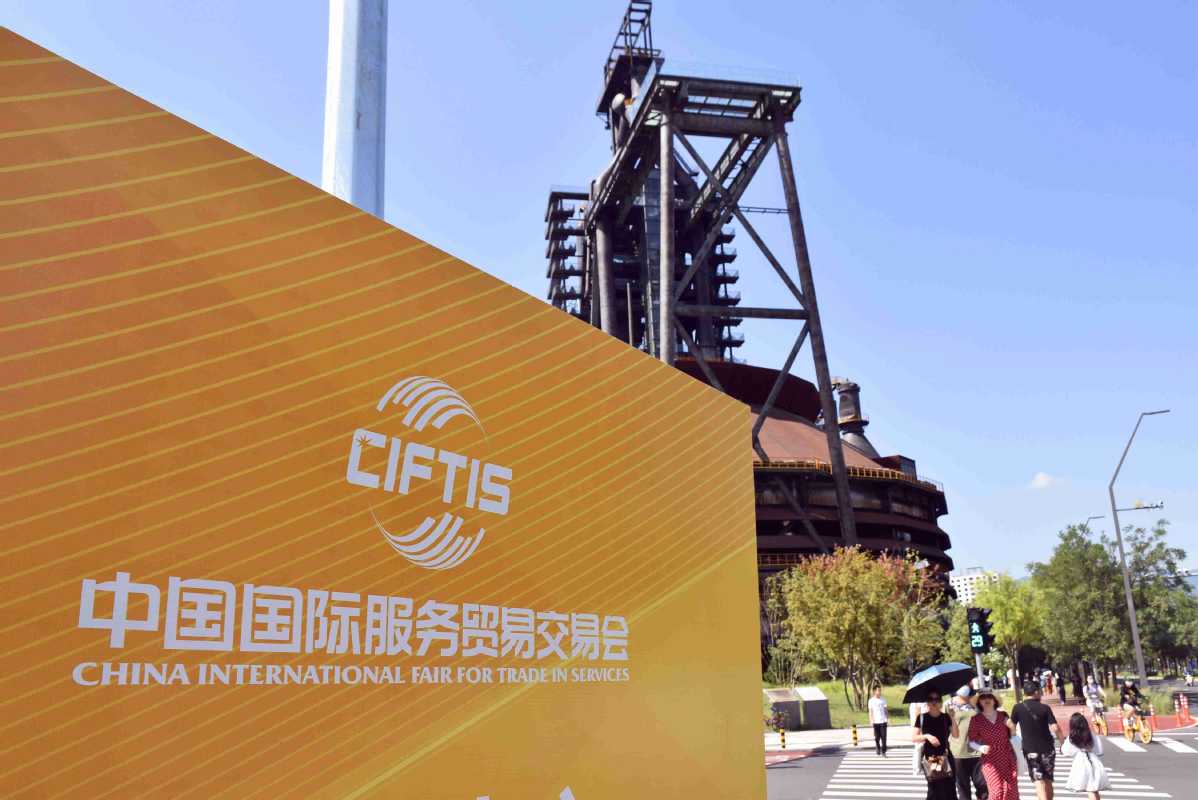China to implement negative list for cross-border trade in services

Pedestrians walk past the venue for the 2022 China International Fair for Trade in Services, which will be held in Beijing from Aug 31 to Sept 5. [Photo/CHINA DAILY]
China will implement a negative list for cross-border trade in services, expand opening-up in the services sector and bolster digital trade to shore up economic growth, said government officials on Tuesday.
A negative list refers to special administrative measures for access of foreign investors to specific fields. China introduced a negative list for cross-border trade in services at the Hainan Free Trade Port last year.
China will seize opportunities brought by the Regional Comprehensive Economic Partnership agreement, which took effect on Jan 1, to expand the scale of trade in services with other member countries in the coming years, said Sheng Qiuping, vice-minister of commerce.
In addition to accelerating the digital transformation of traditional trade in services, and underpinning the growth of smart logistics, online exhibitions and telemedicine, the government will make services more tradable, and advance emerging trade in services such as bonded area-based research and development businesses, product testing, and art exhibition and trade, he said.
Addressing a news conference in Beijing, the official stressed that China will encourage the import of advanced technologies and services for energy conservation, carbon reduction and environmental protection, as well as broaden its exports of green and low-carbon solutions.
In contrast to merchandise trade, trade in services refers to the sale and delivery of intangible services such as transportation, finance, tourism, telecommunications, construction, advertising, computing and accounting.
Wang Dongtang, director-general of the department of trade in services and commercial services at the Ministry of Commerce, said China's trade in services has maintained rapid growth momentum since 2012, with an average annual growth rate of 6.1 percent, about 3.1 percentage points higher than the global growth rate.
The global ranking of China's trade in services has also risen over the years from the third place to second. In fact, by the end of 2021, the nation held onto its second rank for eight consecutive years, he said.
Powered by continuous opening-up, the stable recovery of the services sector and digitalization in services trade, the value of China's trade in services surged 21.6 percent year-on-year to 2.89 trillion yuan ($421.08 billion) in the first half of 2022, data from the commerce ministry showed.
Yang Jinbai, Beijing's vice-mayor, said 71 countries and international organizations will participate in the 2022 China International Fair for Trade in Services-CIFTIS-to be held in Beijing from Aug 31 to Sept 5.
Fifty-nine countries, including the United Arab Emirates, Germany, Italy and the United Kingdom, and 12 international organizations such as the World Meteorological Organization and UNESCO will hold offline exhibitions during the event. Last year, 48 countries and 10 international organizations took part in the event.
Covering an exhibition area of more than 15,200 square meters and focusing on nine themes, including financial, educational, healthcare and supply chain management services, this year's CIFTIS will feature over 400 Fortune 500 companies and industry-leading enterprises, which will set up booths, the organizers said.
A new section has been set up to enrich China's "dual carbon" goals, as the country has announced that it will strive to peak carbon emissions by 2030 and achieve carbon neutrality by 2060.
This year's CIFTIS will include a summit on global trade in services, exhibitions, forums, launch events for new products and technologies, business promotions and discussions, as well as other supporting activities, said Ding Yong, head of the Beijing Municipal Commerce Bureau.
Photos
Related Stories
- Environmental services section to debut at China services trade fair
- Shougang Park in Beijing to be venue for 2022 CIFTIS
- 88 pct of China services trade fair exhibition area booked
- China's major services trade fair opens for media registration
- China to further promote trade of traditional Chinese medicine services
- CIFTIS showcases technology advancement, contributes to upgrading of trade in services
- Integration of technologies and culture captures visitors’ hearts at 2021 CIFTIS
- China International Fair for Trade in Services brings digital technologies, trade in services closer to everyday life
- In pics: CIFTIS in Beijing
- Trade in services speeds up digitalization of world economy
Copyright © 2022 People's Daily Online. All Rights Reserved.









